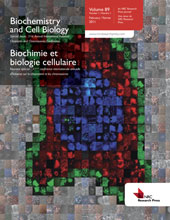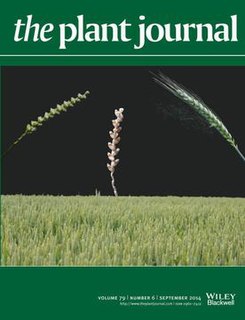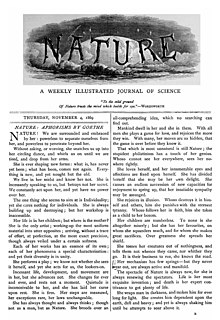
Nature Chemical Biology is a monthly, peer-reviewed, scientific journal, which is published by Nature Publishing Group. It was first published in June 2005. Terry L. Sheppard is a full-time professional editor with the title, "Chief Editor", and employed by Nature Chemical Biology.

Biological engineering, or bioengineering/bio-engineering, is the application of principles of biology and the tools of engineering to create usable, tangible, economically viable products. Biological engineering employs knowledge and expertise from a number of pure and applied sciences, such as mass and heat transfer, kinetics, biocatalysts, biomechanics, bioinformatics, separation and purification processes, bioreactor design, surface science, fluid mechanics, thermodynamics, and polymer science. It is used in the design of medical devices, diagnostic equipment, biocompatible materials, renewable bioenergy, ecological engineering, agricultural engineering, and other areas that improve the living standards of societies. Examples of bioengineering research include bacteria engineered to produce chemicals, new medical imaging technology, portable and rapid disease diagnostic devices, prosthetics, biopharmaceuticals, and tissue-engineered organs. Bioengineering overlaps substantially with biotechnology and the biomedical sciences in a way analogous to how various other forms of engineering and technology relate to various other sciences.
Environmental Science: Processes & Impacts is a monthly peer-reviewed scientific journal covering all aspects of environmental science. It is published by the Royal Society of Chemistry and Kris McNeill is the editor-in-chief. The journal was established in 1999 as the Journal of Environmental Monitoring and obtained its current title in 2013.

Trends in Food Science and Technology is a peer-reviewed review journal covering product development issues in the science and the technology related to food production. It is an official publication of the European Federation of Food Science and Technology and of the International Union of Food Science and Technology. It is edited by Paul Finglas.
The FEBS Journal is a biweekly peer-reviewed scientific journal published by John Wiley & Sons on behalf of the Federation of European Biochemical Societies. It covers research on all aspects of biochemistry, molecular biology, cell biology, and the molecular bases of disease. The editor-in-chief is Seamus Martin, who took over from Richard Perham in 2014.
Biotechnology and Applied Biochemistry is a bimonthly peer-reviewed scientific journal covering biotechnology applied to medicine, veterinary medicine, and diagnostics. Topics covered include the expression, extraction, purification, formulation, stability and characterization of both natural and recombinant biological molecules. It is published by Wiley-Blackwell on behalf of the International Union of Biochemistry and Molecular Biology. The editors-in-chief are Gianfranco Gilardi and Jian-Jiang Zhong.
Phytochemistry is a peer-reviewed scientific journal covering pure and applied plant chemistry, plant biochemistry and molecular biology. It is published by Elsevier and is an official publication for the Phytochemical Society of Europe and the Phytochemical Society of North America.
The Journal of Agricultural and Food Chemistry is a weekly peer-reviewed scientific journal established in 1953 by the American Chemical Society. Since 2015, Thomas F. Hofmann has been the editor-in-chief.

The Journal of Natural Products is a monthly peer-reviewed scientific journal covering all aspects of research on the chemistry and/or biochemistry of naturally occurring compounds. It is co-published by the American Society of Pharmacognosy and the American Chemical Society. The editor-in-chief is A. Douglas Kinghorn.
Molecular and Cellular Biochemistry is a peer-reviewed scientific journal covering research in cellular biology and biochemistry. It was a successor to the journal Enzymologia and was established in 1973 to make "it possible to extend the potentialities of the periodical".

The Journal of Chemical Technology & Biotechnology is a monthly peer-reviewed scientific journal that was established in 1882 as the Journal of the Society of Chemical Industry. In 1950 it changed its title to Journal of Applied Chemistry and volume numbering restarted at 1. In 1971 the journal changed its title to Journal of Applied Chemistry and Biotechnology and in 1983 it obtained the current title. It covers chemical and biological technology relevant for economically and environmentally sustainable industrial processes. The journal is published by John Wiley & Sons on behalf of the Society of Chemical Industry.

Biochemistry and Cell Biology is a bi-monthly, peer-reviewed scientific journal of biochemistry and cell biology established in 1964 by NRC Research Press. It is the continuation of Canadian Journal of Biochemistry and Physiology which split into Canadian Journal of Biochemistry and Canadian Journal of Physiology and Pharmacology in 1964. In 1983, Canadian Journal of Biochemistry was renamed Canadian Journal of Biochemistry and Cell Biology and acquired its current name Biochemistry and Cell Biology in 1986. The journal is edited by James R. Davie and Christopher J. Nelson.

Molecular Microbiology is a bimonthly peer-reviewed scientific journal covering all aspects of molecular microbiology. It was established in 1987 and is published by Wiley-Blackwell. The editor-in-chief is John D. Helmann.

Transgenic Research, international in scope, is a bimonthly, peer-reviewed, scientific journal, published by Springer. The co-editors-in-chief are Paul Christou and Bruce Whitelaw.
SLAS Discovery is a peer-reviewed scientific journal published by the Society for Laboratory Automation and Screening (SLAS) in partnership with SAGE Publications. The editor-in-chief is Robert M. Campbell, Ph.D.. The journal explores how scientists develop and utilize novel technologies and/or approaches to provide and characterize chemical and biological tools to understand and treat human disease. This includes scientific and technical advances in target identification/validation; biomarker discovery; assay development; virtual, medium- or high-throughput screening; lead generation/optimization; chemical biology; and informatics. The journal was published from 1996 through 2016 with the title Journal of Biomolecular Screening. Its name changed in 2017 to more accurately reflect the evolution of its editorial scope.[1]

Journal of Biotechnology is a peer-reviewed scientific journal covering research ranging from genetic and molecular biological positions to biochemical, chemical, or bioprocess engineering aspects as well as research on the computer application of new software concepts which are directly relevant to biotechnology.
Yoshizumi Ishino is a Japanese molecular biologist, known for his discovering the DNA sequence of Clustered Regularly Interspaced Short Palindromic Repeats (CRISPR).
Animal Science Journal is a monthly peer-reviewed scientific journal covering research in dairy agriculture and animal science. The journal was established in 1930 and is published by John Wiley & Sons, Inc. on behalf of the Japanese Society of Animal Science. The editor-in-chief is Masahiro Satoh.

The Plant Journal is a peer-reviewed scientific journal of plant science published by Wiley-Blackwell for the Society for Experimental Biology. It was established in 1991 and is currently edited by Lee Sweetlove. The journal is published twice per month.















